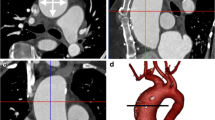Summary
Purpose: To investigate whether phase-contrast MRA is a clinically suited approach to examine arteries of the pelvis and lower extremities.
Methods: The study was divided into two parts, a volunteer study and patient study. Three MRA techniques – 2D TOF with venous saturation, 3D magnitude contrast and 2D phase contrast with ECG triggering – were intraindividually compared in 15 volunteers and evaluated by three blinded readers. Subsequently, a total of 230 vessel segments of 45 MRA studies using ECG-triggered phase contrast were compared with intraarterial DSA. All vessel segments were scored by three blinded readers using a five-point scale with DSA serving as the gold standard.
Results: ECG-triggered phase contrast provided better image quality than the other MRA techniques as assessed by the Friedman test. Clinical studies demonstrated a significant correlation of DSA and MRA as assessed by the Spearman correlation and kappa statistics for individual readers.
Conclusion: MRA of the pelvis and lower extremities may be performed with 2D ECG-triggered phase-contrast MRA within a reasonable time frame ( < 30 min). MRA slabs provide orientation similar to that with DSA projections and good to very good correlation of vessel pathology as shown by kappa statistics.
Zusammenfassung
Ziel der Studie war die Entwicklung einer praktikablen Untersuchungsstrategie für die MRA der unteren Extremität. Im Probandenteil der Studie wurden 3 MRA-Techniken (2D-TOF mit venöser Sättigung, 3D-Magnitude-Kontrast und 2D-Phasenkontrast mit EKG-Triggerung) intraindividuell prospektiv verglichen. Im Patiententeil der Studie wurden bei n = 45 klinischen MRA-Untersuchungen mittels EKG-getriggerter 2D-PCA 230 Gefäßsegmente intraindividuell mit der arteriellen DSA nach einem fünfstufigen Scoresystem verglichen. EKG-getriggerte PCA-Techniken zeigten die beste Bildqualität in allen Gefäßabschnitten. Dabei betrug der mittlere Rang des Friedman-Testes der PCA-Technik in der Beckenetage 1,2 und an der Oberschenkel- bzw. Knie-/Unterschenkeletage 1,0. Die Patientenuntersuchungen zeigten eine gute Übereinstimmung von DSA und MRA mit einem signifikanten Spearman-Korrelationskoeffizient für die Becken-, Oberschenkel- und Knieetage. MRA-Untersuchungen der unteren Extremität sind unter Einsatz der EKG-getriggerten 2D-PCA-Technik mit vertretbarem Zeitaufwand möglich. Die Abbildungmöglichkeiten der untersuchten Gefäßetagen entsprechen den Bildeinstellungen der DSA und die klinische Auswertung ergab eine gute (Kappa > 0,61) bis sehr gute (Kappa > 0,81) Übereinstimmung in der Beurteilung pathologischer Gefäßveränderungen.
Similar content being viewed by others
Author information
Authors and Affiliations
Rights and permissions
About this article
Cite this article
Reimer, P., Wilhelm, M., Lentschig, M. et al. Phase-contrast MR angiography of the lower extremity. Comparison of methods and clinical application. Radiologe 37, 572–578 (1997). https://doi.org/10.1007/s001170050255
Issue Date:
DOI: https://doi.org/10.1007/s001170050255




